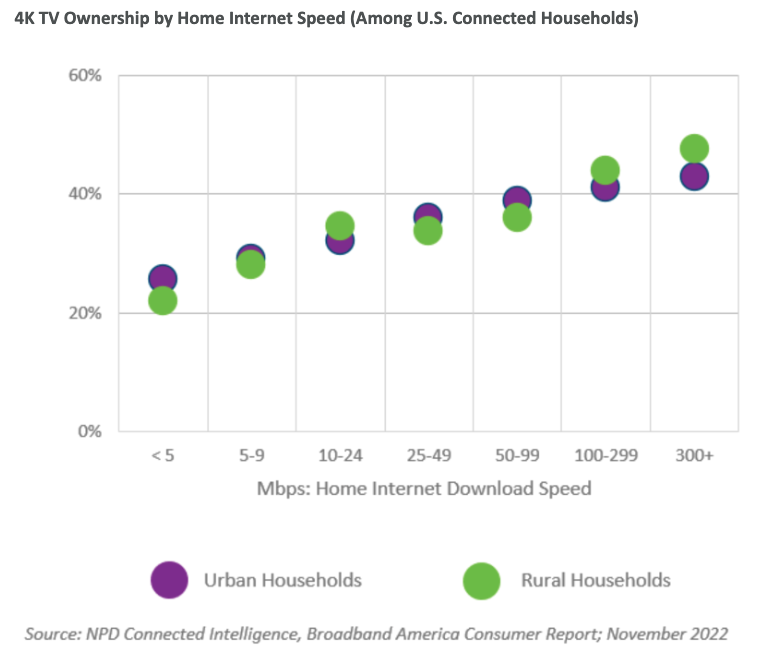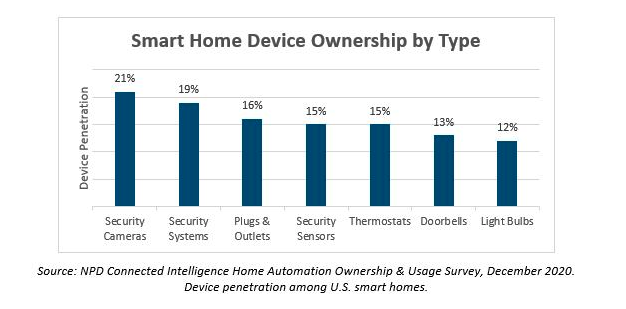Port Washington, NY, March 8, 2022 – For many a broadband connection means having the ability to stream the latest binge-worthy shows, conference call with colleagues who are miles away, and monitor your home via smart devices from another state. But over the course of the pandemic broadband connections played a role in all that and more, keeping students connected to the classroom and patients connected to their doctors via telehealth. Despite the growing reliance on connected technology, the new Broadband America report from The NPD Group reveals that only 50% of homes in the continental U.S. have true broadband speed of 25Mbps download or higher.
In fact, 34% of homes receive internet access at speeds of less than 5Mbps, including 15% that do not have any internet access. Vermont, West Virginia, New Mexico, and Mississippi are among the least connected states, while New Jersey, Rhode Island, Maryland, and California are among the most connected. In Vermont only 24% of homes receive broadband speeds, while in New Jersey 65% of homes do.
“The so-called digital divide is a result of many factors including availability of suitable internet services and the affordability of services that are available in more rural parts of America,” explained Eddie Hold, president, NPD Connected Intelligence. “But there is potential for this situation to improve relatively quickly, as a result of the American Rescue Plan Act and the Infrastructure Investment and Jobs Act, which are providing key subsidies for deploying faster internet services, as well as funding the Affordable Connectivity Program which provides subsidized internet service to lower-income homes.”
According to NPD’s Rural America report, more rural and less connected areas of the U.S. have far lower ownership levels of connected devices, as well as a higher level of price sensitivity for technology products ranging from TVs to streaming media players and beyond. In fact, while TV unit sales are roughly the same across rural and non-rural areas, the average price is 40% lower. When looking at streaming media players, unit sales are nearly 60% lower in rural areas.
“The lack of higher-speed internet limits the opportunity for newer devices and services, as customers do not have the connectivity needed to generate a satisfactory experience,” noted Hold. “That has a ripple-on effect for consumer technology, limiting the need for larger, smarter TVs, streaming devices, or even tablets and newer PCs.”
Methodology
The report is based on a combination of sales data, speed test results, consumer surveys, FCC data and other sources to create a comprehensive view of the connected state of America today.
About Connected Intelligence
Connected Intelligence provides competitive intelligence and insight on the rapidly evolving consumer’s connected environment. The service focuses on the three core components of the connected market: the device, the broadband access that provides the connectivity and the content that drives consumer behavior. These three pillars of the connected ecosystem are analyzed through a comprehensive review of what is available, adopted, and consumed by the customer, as well as reviewing how the market will evolve over time and what the various vendors can do to best position themselves in this evolving market. For more information: http://www.connected-intelligence.com.
About The NPD Group, L.P.
NPD is a global market information company offering data, industry expertise, and prescriptive analytics to help our clients understand today’s retail landscape and prepare for the future. Over 2,000 companies worldwide rely on us to help them measure, predict, and improve performance across all channels, including brick-and-mortar, e-commerce, and B2B. We have services in 19 countries worldwide, with operations spanning the Americas, Europe, and APAC. Practice areas include apparel, appliances, automotive, beauty, books, B2B technology, consumer technology, e-commerce, fashion accessories, food consumption, foodservice, footwear, home, home improvement, juvenile products, media entertainment, mobile, office supplies, retail, sports, toys, and video games. For more information, visit npd.com. Follow us on Twitter: @npdgroup.
Press Contact
Megan Scott
516.625.7516
megan.scott@npd.com

